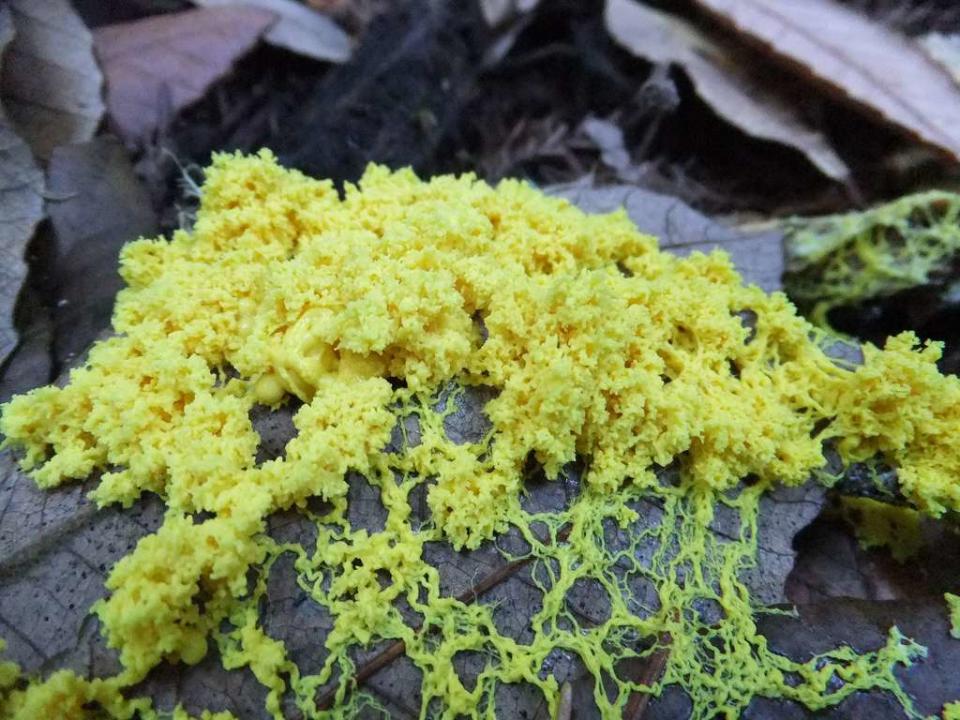The Uncanny Intelligence of Slime Mold
Who says you need an actual brain to be smart? Researchers add advanced problem-solving to the slime mold’s bag of clever tricks.

Physarum polycephalum is a single-cell organism that can grow to several square yards in size. It likes the shady, cool, and moist environs of the forest floor, where it extends its oozy tendril-branches in search of prey. It is neither plant nor animal or fungus, but a gelatinous amoeba that is coaxing scientists into rethinking intelligent behavior. Although its name means “many-headed slime,” it actually has no brain, which makes its skillset even more remarkable.
P. polycephalum has been shown to solve complicated mazes, anticipate events, remember where it has been, construct transport networks comparable to those designed by human engineers and even make irrational decisions—something long-considered the private domain of those of us with brains.
But that's not all. A 2016 study by researchers from the New Jersey Institute of Technology (NJIT), the University of Sydney, the University of Sheffield, and the University of Leeds researchers have found that this bright yellow slimy blob has excellent decision-making capabilities, as measured by its success in figuring out the two-armed bandit problem. The study authors write:
This [two-armed bandit] problem has previously only been used to study organisms with brains, yet here we demonstrate that a brainless unicellular organism compares the relative qualities of multiple options, integrates over repeated samplings to perform well in random environments, and combines information on reward frequency and magnitude in order to make correct and adaptive decisions.
Way to go, slime mold!
The two-armed bandit problem is a classic test to determine decision-making abilities, and it is typically used for creatures with brains. In the experiment, two levers are offered, each of which proffers a random reward. One of the levers more frequently delivers a better reward, so researchers look for when the subject figures it out and decides to stick with the higher-rewarding lever. Known as the “exploration-exploitation tradeoff,” the phenomenon is relevant beyond slot machines; it can apply to situations as diverse as investors picking start-up companies to drivers selecting a parking space.
Since slime molds don’t have arms with which to pull levers, the researchers adapted the experiment by giving them the choice to explore two opposite paths peppered with food as the reward.
What the researchers found is that the slime mold was able to compare the relative qualities of multiple choices and most often opted for the direction with the higher overall concentration of food. “It was able to sum up the number of food patches encountered in each direction, as well as the quantity of food present at each patch to make correct and adaptive decisions as to the direction it should move next.”
"Working with Physarum constantly challenges our preconceived notions of the minimum biological hardware that is required for sophisticated behavior," says principal investigator of the study, Simon Garnier.
So maybe P. polycephalum doesn’t fall in love or write music or ponder existential mysteries as humans do, but it’s remarkable to consider how other creatures live and “think,” even without brains. We all have our place on this planet, and even odd blobs of slime deserve respect for mastering their bit of forest floor.
As the study concludes, “Our results show that taking a wider, more inclusive view of cognition allows a greater appreciation for the broad diversity of information processing, problem-solving and decision-making strategies spread across all taxa.”
Indeed! See some of P. polycephalum's tricks in the nifty video below.

